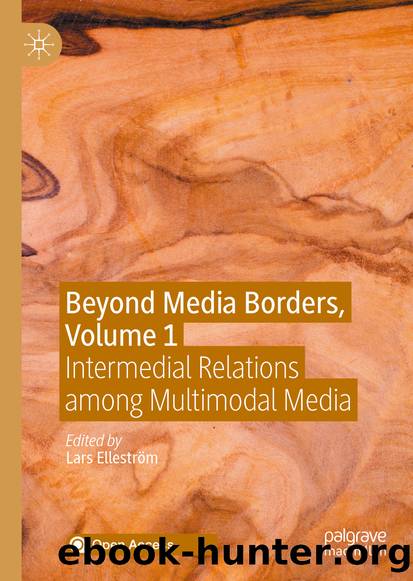Beyond Media Borders, Volume 1 by Unknown

Author:Unknown
Language: eng
Format: epub
ISBN: 9783030496791
Publisher: Springer International Publishing
2.8 Conclusion
At the beginning of this chapter, it was highlighted in many of the references that theatre was a particularly special form of qualified medium, a hypermedium and an expansive and generous host to all other qualified media whose materiality it deftly embraced intact but reframed with theatrical signification. Using Elleströmâs modalities of media, my intention in this chapter has been to enhance these statements by Georgi, Kattenbelt and others by establishing the significance of the spatiotemporal and sensorial modalities, alongside the material modality, in realising the hypermedium and to shed greater light on what this specific hybridised theatrical signification may look like and what it may accomplish.
The mobility of materiality is undoubtedly the most obvious of distinctions for theatre in this context as objects, bodies, recordings, screens, social media feeds and so on can all be enfolded within a theatrical event. This material mobility can be extended to the consideration of theatre as a technical medium, a physical host for performance. Unlike other qualified media, theatre can inhabit and shift through endless technical hosts, from traditional West End theatres to Birmingham residential towers, from London skyscrapers to Australian hotel complexes and far beyond. A single theatre performance can commence in one type of space and traverse through multiple other spaces (pavements, bedrooms, churches, etc.), appropriated as the technical media of theatre for the time they are required and then jettisoned back to their original context. Other qualified media are arguably not so flexible, as despite ongoing experimentations, fine art generally requires (or is perceived commercially to require) some form of canvas to realise the basic medium of visual images and literature needs the pages of a book or a digital device to realise the basic medium of written text. It may be initially argued that art, for example, can be galleried in any location but the gallery is not the technical medium of art; it is just one location, contextually agreed by society, to observe the qualified medium of fine art. The act of perception in fine art can be substantially, if not entirely, delineated from the context in which the media products of art are observed. We may profoundly contemplate a masterpiece by Hockney or OâKeefe in the privacy of our own home with a copy purchased online, but this is not possible with theatre, even when spectating online, as we are always cognisant of the physical context. Location for theatre is the equivalent of canvas or a book; it is intrinsic to the form, enmeshed within the media products of theatre and hence the cognitive import.
Beyond the significance of material mobility, the influence of specific spatiotemporal and sensorial affordances within the hypermedium is likewise not to be underestimated. Through such affordances, new and imaginative angles of mediation are crafted by theatre-makers to reveal the medial arrangement whilst simultaneously saturating you, often inculcating you, in the virtual domain. Theatre, particularly participatory and immersive practice, has the extraordinary capacity to suspend the audience between the extracommunicational and intracommunicational domains
Download
This site does not store any files on its server. We only index and link to content provided by other sites. Please contact the content providers to delete copyright contents if any and email us, we'll remove relevant links or contents immediately.
| Anthropology | Archaeology |
| Philosophy | Politics & Government |
| Social Sciences | Sociology |
| Women's Studies |
Cecilia; Or, Memoirs of an Heiress — Volume 1 by Fanny Burney(32440)
Cecilia; Or, Memoirs of an Heiress — Volume 2 by Fanny Burney(31875)
Cecilia; Or, Memoirs of an Heiress — Volume 3 by Fanny Burney(31858)
The Great Music City by Andrea Baker(31539)
We're Going to Need More Wine by Gabrielle Union(18973)
All the Missing Girls by Megan Miranda(15598)
Pimp by Iceberg Slim(14399)
Bombshells: Glamour Girls of a Lifetime by Sullivan Steve(13979)
Talking to Strangers by Malcolm Gladwell(13233)
Norse Mythology by Gaiman Neil(13216)
Fifty Shades Freed by E L James(13163)
For the Love of Europe by Rick Steves(13121)
Mindhunter: Inside the FBI's Elite Serial Crime Unit by John E. Douglas & Mark Olshaker(9212)
Crazy Rich Asians by Kevin Kwan(9174)
The Lost Art of Listening by Michael P. Nichols(7412)
Enlightenment Now: The Case for Reason, Science, Humanism, and Progress by Steven Pinker(7242)
The Four Agreements by Don Miguel Ruiz(6641)
Bad Blood by John Carreyrou(6559)
Weapons of Math Destruction by Cathy O'Neil(6152)
